
Most of the time the existing solution works just fine, but then you end up with things like 1+1.03=2.0300000000000002 (generally with slightly larger numbers since it's used for things like the roasted coffee not fitting in one bucket and adding the two bucket weights together) instead of the expected 2.03. Other options are heuristic hacks or exposing a setting for decimal places, but SQL already specifies the behavior I want so as much as I hate this "solution" I'll go with it for now.
Considering switching the mathable fields in Typica away from using the ECMA-262 host environment and instead letting SQLite do the arithmetic for me because that's less work than implementing a proper solution myself, is less work and doesn't come with license issues compared with some of the libraries I looked at, and Typica 2 already has an SQLite dependency anyway and has better behavior for this use case.
We've decided to tweak our annual start of the year fundraiser for the local food bank. This time we're donating a smaller proportion of sales but running the period that we do that for longer so that we can get what we expect to be a higher sales day into the period, give more people a chance to notice that it's a thing if they want to bring in their own food/cash donations for us to pass along with ours.
First task of today was finishing up some work on blend adjustments. First one was just checking that a direct substitution of the new coffee into the old recipe works and it did. The espresso blend was going to be a bit more work. Took 4 attempts to get the flavor profile where I wanted that, but I'm very happy with the result there.
There''s been a big uptick in people placing orders and then calling us to make sure we got their order (sometimes as soon as an hour after the order was placed).
If the web site told you the order got placed, the order got placed.
Also, please learn to check your spam folders and if Microsoft is running your mail account it's probably their fault that you're not seeing expected emails (Hotmail gave up on competence a long time ago and I can't fix your choice to use a crap provider).
Not that I plan on uploading any of this and pretending that I'm any kind of visual artist, but I recently had a play with diffusion models (that run surprisingly decently on my old laptop) and as near as I can tell they're good for generating various types of cosmic horrors and social media profile pictures of anime catgirls.
Some coffees have distinct cuts where at certain points you get a big, distinct change in cup character, so you have maybe 2-4 categories of general characteristics you can aim for and manipulate the roast within, and those are interesting in their own way, but here it's really all just levels and intensities shifting and deciding what kind of balance you want.
Today I'm working on my latest arrival from Brazil and the initial exploratory roast would make for a pretty interesting training exercise. I have 9 cups, each representing a different potential end point ranging from start of 2nd crack through to a bit beyond what I'd like as a French Roast, and within that, the core characteristics of the coffee are remarkably stable, which makes it a good example of what you can generally expect as coffee gets darker.
Odds are good that Typica 2.0 will have a significant change to its main serialization. Most won't have to care about the difference, but it's both a significant reduction in file size and nicer for anybody doing by hand edits (though now that CRUCS exists, nobody should be doing that). Main downside I can think of is it'll break any XSLT workflows, but as far as I know, nobody is doing that. Might be worth asking the mailing list if it'll affect anybody anyway.
- Software
- https://typica.us
- Send Money
- https://typica.us/payment.html
Author of Typica software for coffee roasters.
